How to Format SD Card to NTFS on PC and Android
Can You Format SD Card to NTFS?
The SD card is a portable storage device commonly used in cameras, camcorders, and mobile phones to expand internal memory, and is compatible with the FAT file system. However, if you want to use it as a storage device in a Windows laptop and an Android phone or tablet, you may need to format the card from FAT32 to NTFS, which can be achieved using one of the three most widely used SD card formatter tools.
To convert an SD card to NTFS using Qiling Partition Master, follow these steps: First, download and install Qiling Partition Master on your computer. Next, connect your SD card to your computer via a card reader. Launch Qiling Partition Master and select the SD card from the list of available drives.
To format an SD card to NTFS in Windows Disk Management, open the Disk Management utility by searching for it in the Start menu. In the Disk Management window, right-click on the SD card drive and select "Format." In the Format window, select the file system as "NTFS" and choose the allocation unit size.
To format your SD card to NTFS in Windows File Explorer, follow these steps: Open File Explorer and find your SD card under 'This PC' or 'Devices and drives.' Right-click on the SD card and select 'Format.' In the 'Format' window, select 'NTFS' from the 'File system' dropdown menu.
Essential Backup Before Formatting SD Card
Formatting a storage device, such as a memory card, USB flash drive, internal or external hard drive (HDD) or solid state drive (SSD), prepares it for initial use by erasing all data and resolving issues like RAW and corruption. This process starts the device fresh, but be aware that all data will be completely deleted.
If you're formatting an SD card using the default Windows Explorer or Disk Management, you'll need to copy any existing data to another drive first. However, you can use a third-party partition manager like Qiling to convert the SD card from FAT32 or exFAT to NTFS without losing any data.
How to Format SD Card to NTFS in Windows 10/8/7 (3 Ways)
The recommended three ways to format a microSD card, SD card, SDHC card, or SDHX card are generally easy to use and don't require much knowledge. You can format the card for use with Android phones, digital cameras, camcorders, Nintendo DS or 3DS as you prefer.
Option 1. Convert SD Card to NTFS with Qiling Partition Master
Qiling Partition Master is a free partition manager that helps with disk-related issues, allowing you to convert different file systems, such as FAT16/32/exFAT/EXT, to NTFS while preserving your data.
Step 1. Open Qiling Partition Master. Connect the your SD card to PC.
Step 2. To format a partition to FAT32, select the partition, click on it, and select "Format". If you need to convert a storage device like an SD card or USB flash drive to NTFS, insert the device into your PC and repeat the process.
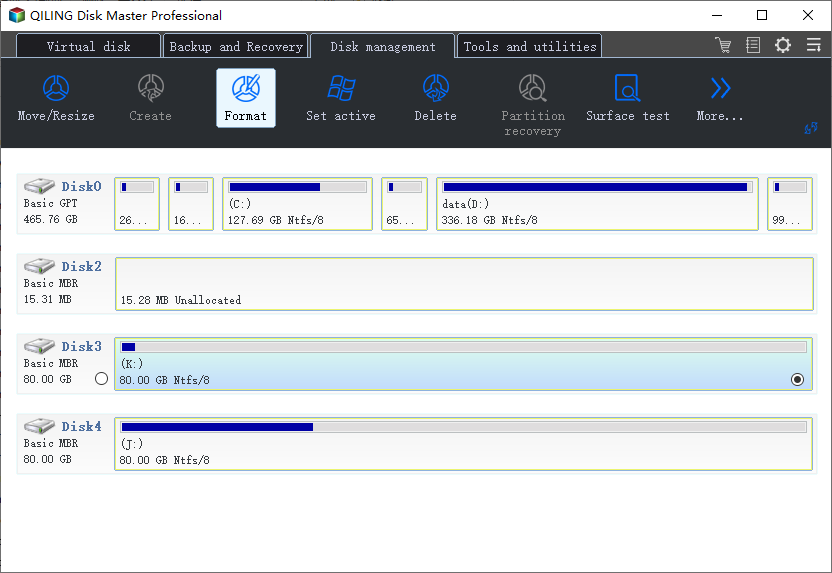
Step 3. In the next window, enter the partition label, choose the NTFS file system, and set the cluster size according to your needs, then click "Proceed".
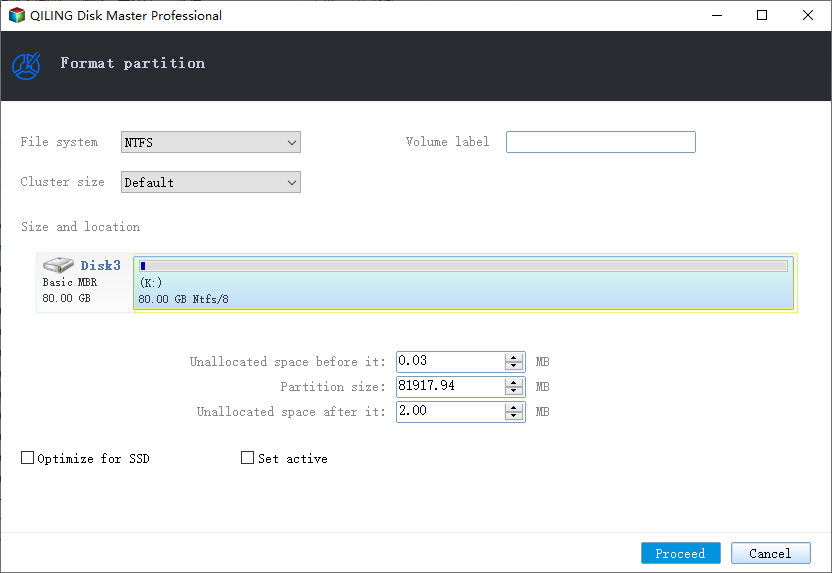
Qiling Partition Master helps format an SD card to NTFS or other file systems quickly and effectively. It also offers various other features, including resizing or moving partitions, merging partitions, converting between GPT and MBR, migrating OS, copying partitions, and more, making it a versatile disk management tool.
Option 2. Format SD card to NTFS in Disk Management
Step 1. In Windows 10/8/7, press Windows +R keys to open the Run box, type diskmgmt.msc, and hit Enter to access the Windows Disk Management.
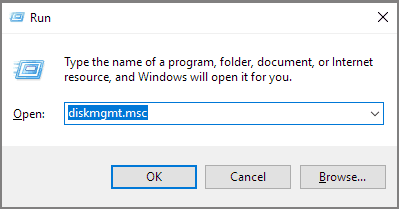
Step 2. Locate the SD card, right-click on it and choose "Format".
Step 3. In the Format dialogue, select NTFS as the target file system and use the default allocation unit size for the SD card, then perform a quick format.
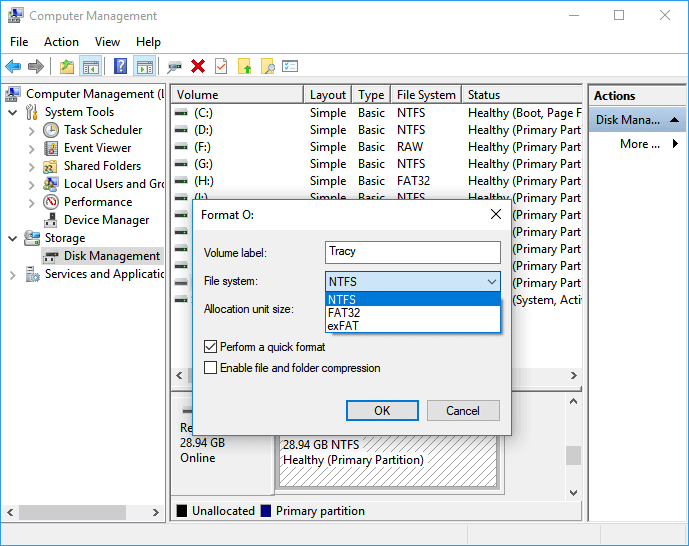
Format SD Card NTFS allocation unit size, how to choose?
The default setting is usually the best choice for most users, as it provides a balance between features and simplicity. However, if you're looking for more advanced options, you can explore the settings further by reading the explanation from experts, which can provide a deeper understanding of the features and how they work.
Microsoft recommends keeping the default allocation unit size for standard users, as it aligns with the block size of the NTFS formatted hard drive. For users with many small files, a smaller allocation unit size is beneficial to avoid wasting hard drive space. Conversely, users with large files may see improved system performance by keeping a higher allocation unit size, resulting in fewer blocks to seek.
To be honest, the difference in hard drive capacity is becoming less significant, so choosing the right allocation size is not as crucial as it used to be. It's usually best to stick with the default allocation size, as most files are relatively small, and larger files are usually large in size but not in units.
Option 3. Format SD Card to NTFS in Windows File Explorer
Step 1. In Windows 10/8/7, press Windows + E keys to open the Explorer.
Step 2. Click on the SD card and choose "Format".
Step 3. Choose NTFS as the target file system and perform a quick format. Click "Proceed".
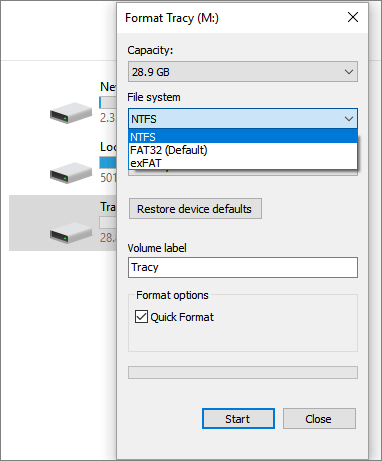
Formatting an SD card in Windows Explorer can sometimes result in the error message "Windows was unable to complete the format". This issue can be resolved through further troubleshooting in two steps: Option 1 involves checking the SD card for physical damage, updating the SD card driver, and running a disk check, while Option 2 involves using the built-in Windows Disk Management tool to format the SD card.
To Sum Up
Formatting an SD card to NTFS can be done using three free methods. Each method is effective, but they differ in approach: native Windows programs will erase data on the card, while third-party tools like Qiling Partition Master can convert the file system to NTFS without affecting data.
Windows Explorer and Disk Management may not be able to format an SD card to FAT32, especially if the capacity exceeds 32GB, due to a long-standing defect. In such cases, using Qiling Partition Master is necessary to format a 64GB SD card to FAT32.
Related Topic: Should You Format Android SD Card to NTFS or FAT32?
Android supports FAT32 and EXT4 file systems, but not NTFS. If you insert an NTFS formatted SD card or USB drive, it won't be recognized by your Android device. Most SD cards are formatted to FAT32, while larger ones are formatted to exFAT, and should be formatted to FAT32 for use with Android.
Read further: FAT32 vs NTFS: What's the Difference?
Related Articles
- Convert FAT32 to NTFS Without Losing Data
- Diskpart Has Encountered an Error Access Is Denied | How to Fix
- 2022 Solved: Unable to Format SD Card, SD Card Won't Format on PC/Android
- Qiling Partition Master Full Version Free Download with Serial Code/Key
- Fixed: The Disk Is Write Protected Windows 11
- [Samsung Data Migration Windows 10/11] Clone A Hard Drive with Samsung Disk Cloner